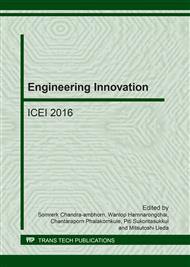[1]
K. Yang, S. Yu, Y. Li, and C. Li, Effect of carbonitride precipitates on the abrasive wear behaviour of hardfacing alloy, Appl. Surf. Sci. 254 (2008) 5023-5027.
DOI: 10.1016/j.apsusc.2008.01.154
Google Scholar
[2]
M. El Mansori, M. Nouari, Dry machinability of nickel-based weld-hardfacing layers for hot tooling, Int. J. Mach. Tool. Manu. 47 (2007) 1715-1727.
DOI: 10.1016/j.ijmachtools.2006.12.007
Google Scholar
[3]
S. Aykut, E. Bagci, A. Kentli, O. Yazıcıoğlu, Experimental observation of tool wear, cutting forces and chip morphology in face milling of cobalt based super-alloy with physical vapour deposition coated and uncoated tool, Materials & Design. 28 (2007).
DOI: 10.1016/j.matdes.2006.04.014
Google Scholar
[4]
W. Pedersen, M. Ramulu, Facing SiCp/Mg metal matrix composites with carbide tools, J. Mater. Process. Tech. 172 (2006) 417-423.
DOI: 10.1016/j.jmatprotec.2005.07.016
Google Scholar
[5]
Y.S. Liao, H.M. Lin, Y.C. Chen, Feasibility study of the minimum quantity lubrication in high-speed end milling of NAK80 hardened steel by coated carbide tool, Int. J. Mach. Tool. Manu. 47 (2007) 1667-1676.
DOI: 10.1016/j.ijmachtools.2007.01.005
Google Scholar
[6]
J. Gu, G. Barber, S. Tung, R. -J. Gu, Tool life and wear mechanism of uncoated and coated milling inserts, Wear. 225-229 (1999) 273–284.
DOI: 10.1016/s0043-1648(99)00074-5
Google Scholar
[7]
M.V. d. Carvalho, D.M. Montenegro, J. d.O. Gomes, An analysis of the machinability of ASTM grades 2 and 3 austempered ductile iron, J. Mater. Process. Tech. 213 (2013) 560-573.
DOI: 10.1016/j.jmatprotec.2012.11.004
Google Scholar
[8]
B. AkyuZ, Influence of aluminum content on machinability of AS series cast magnesium alloys, T. Nonferr. Metal. Soc. 24 (2014) 3452-3458.
Google Scholar
[9]
X.J. Ren, Q.X. Yang, R.D. James, L. Wang, Cutting temperatures in hard turning chromium hardfacings with PCBN tooling, J. Mater. Process. Tech. 147 (2004) 38-44.
DOI: 10.1016/j.jmatprotec.2003.10.013
Google Scholar
[10]
S. Chinchanikar, S.K. Choudhury, Investigations on machinability aspects of hardened AISI 4340 steel at different levels of hardness using coated carbide tools, Int. J. Refract. Met. H. 38 (2013) 124-133.
DOI: 10.1016/j.ijrmhm.2013.01.013
Google Scholar
[11]
M. Rahman, A.S. Kumar, M.U. Salam, M.S. Ling, Effect of Chilled Air on Machining Performance in End Milling, Int. J. Adv. Manuf. Tech. 21 (2003) 787-795.
DOI: 10.1007/s00170-002-1394-z
Google Scholar
[12]
H.A. Kishawy, M. Dumitrescu, E.G. Ng, M. A. Elbestawi, Effect of coolant strategy on tool performance, chip morphology and surface quality during high-speed machining of A356 aluminum alloy, Int. J. Mach. Tool. Manu. 45 (2005) 219-227.
DOI: 10.1016/j.ijmachtools.2004.07.003
Google Scholar
[13]
Z. Liu, Q. An, J. Xu, M. Chen, S. Han, Wear performance of (nc-AlTiN)/(a-Si3N4) coating and (nc-AlCrN)/(a-Si3N4) coating in high-speed machining of titanium alloys under dry and minimum quantity lubrication (MQL) conditions, Wear 305 (2013).
DOI: 10.1016/j.wear.2013.02.001
Google Scholar
[14]
A. Devillez, G. Le Coz, S. Dominiak, and D. Dudzinski, Dry machining of Inconel 718, workpiece surface integrity, J. Mater. Process. Tech. 211 (2011) 1590-1598.
DOI: 10.1016/j.jmatprotec.2011.04.011
Google Scholar


